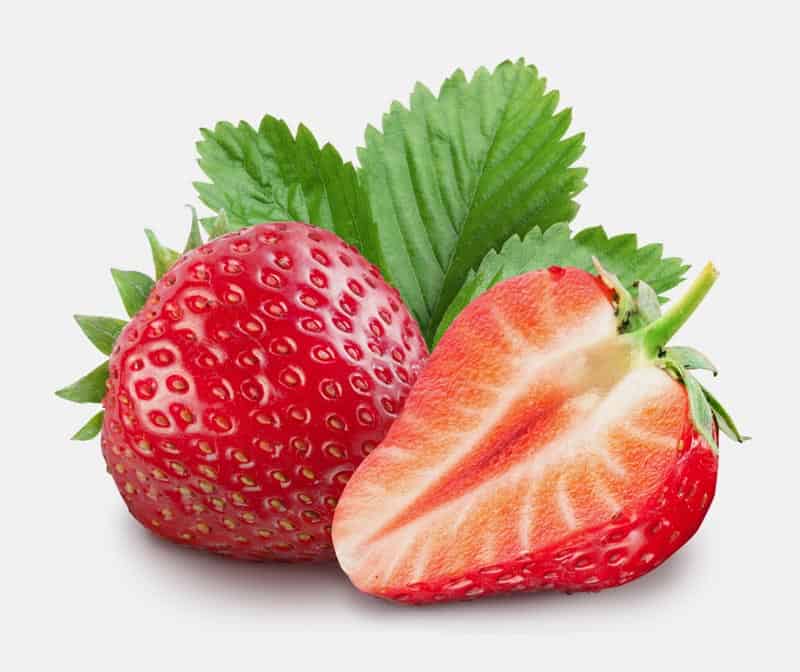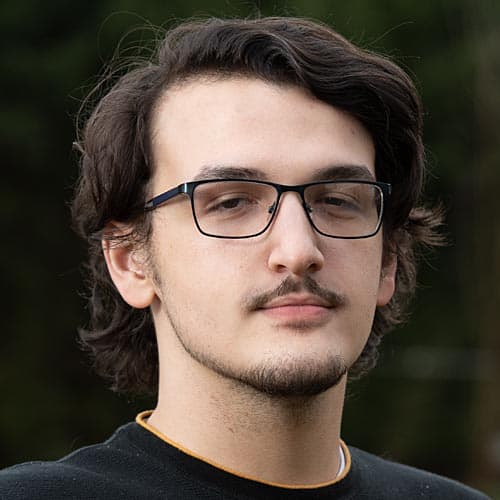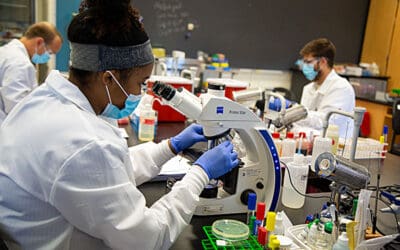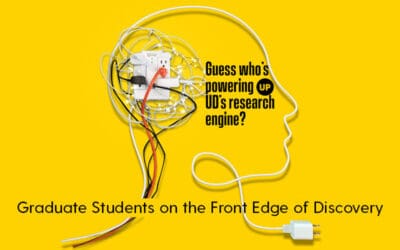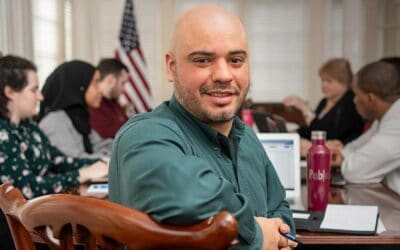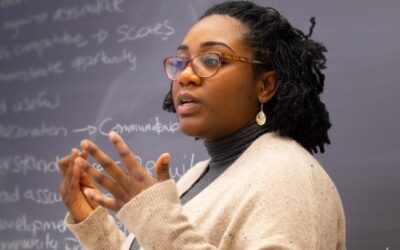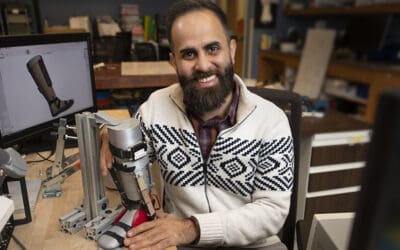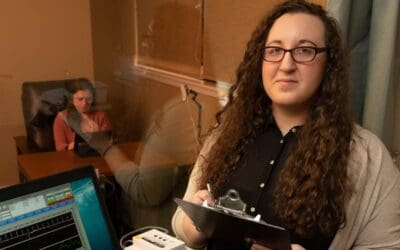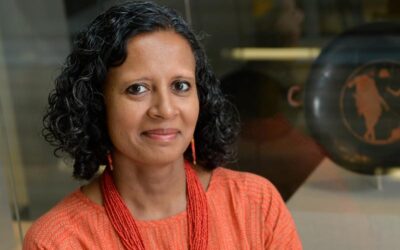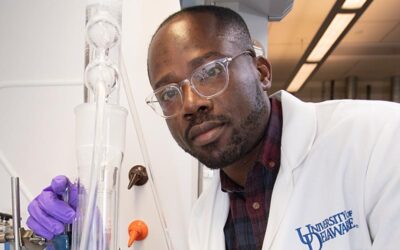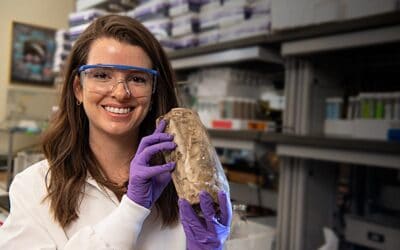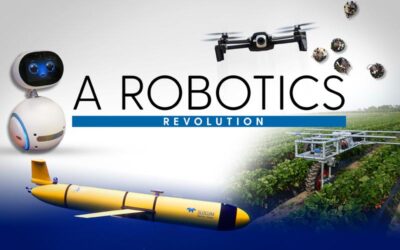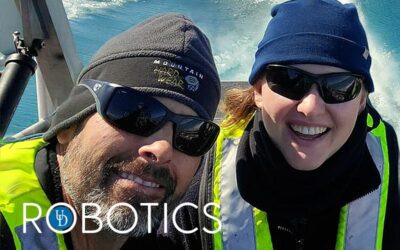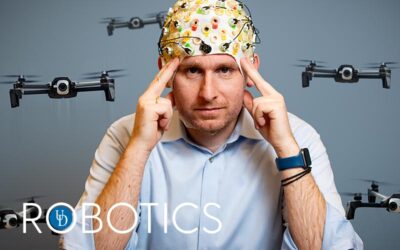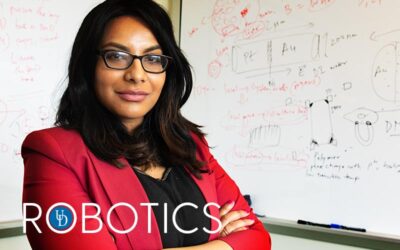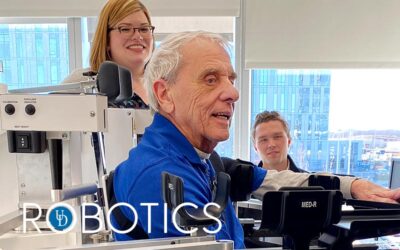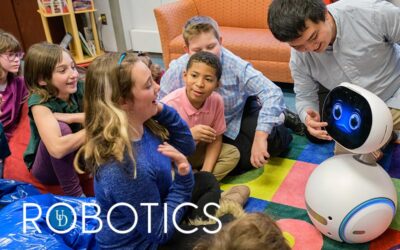UD ROBOTICS
An autonomous field robot delivers nonchemical pest protection
Predicting when in the growing cycle pests will appear is difficult, making regular treatment necessary and costly for farmers. The TRIC Robotics team, led by Adam Stager and involving several UD undergraduate students, has developed an autonomous field robot with the ability to travel up and down the rows in a strawberry field, delivering nonchemical pest protection right to the strawberries themselves. The field robot leverages UVC light technology, developed by USDA scientists.
Startup with roots at UD provides chemical-free pest control for strawberry farmers
by Karen Roberts
“I was always thinking, ‘This is a pencil, but it could be a better pencil if…,’” said Stager, a postdoctoral researcher in the University of Delaware’s College of Agriculture and Natural Resources (CANR).
Stager also is the founder of TRIC Robotics, a startup company focused on offering strawberry farmers a viable alternative to pesticides.
The TRIC Robotics team, which includes several UD undergraduate students, has developed an autonomous field robot with the ability to travel up and down the rows in a strawberry field, delivering nonchemical pest protection right to the strawberries themselves. The field robot leverages UVC light technology, developed by USDA scientists.
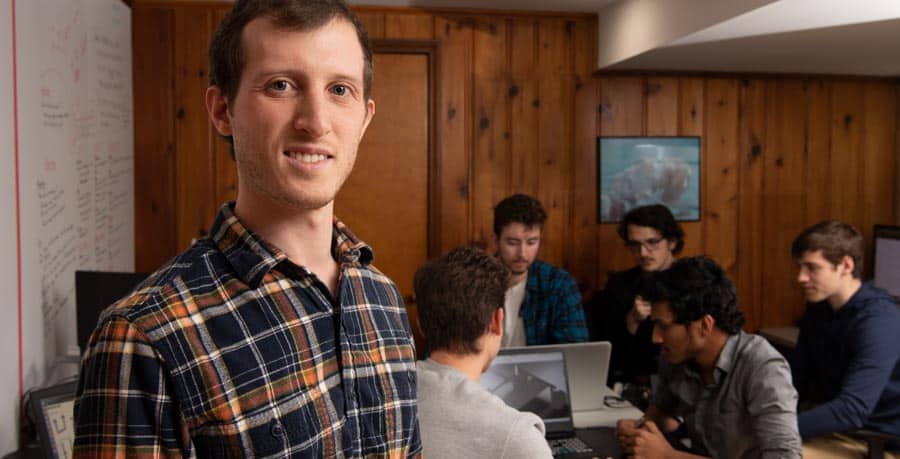
ABOVE: Entrepreneur Adam Stager, founder of TRIC Robotics, believes uplifting the creative talents of others is an important part of building a business. He might be the idea guy, but he says each member of the TRIC Robotics team plays a critical role in the company’s success. Pre-pandemic photo by Kathy Atkinson
“Think of it like a car-sized Roomba, but instead of cleaning carpets, it carries a special UVC light that kills pests originally targeted by pesticides,” said Vishnu Somasundaram, a biomedical engineering major and one of the first undergraduate students to join the project.
Some pesticides are harmful to the environment and toxic. Predicting when in the growing cycle pests will appear is difficult, making regular treatment necessary and costly for farmers.
UVC light comes from sunlight, and it disrupts a living organism’s DNA. The more complex the organism, the more time this disruption takes. In the environment, UVC light is blocked by the ozone layer. Targeted at strawberry plants, UVC light can kill pests in as little as 15 seconds of treatment. It has been shown to be as effective as pesticides on the three largest yield reducers for strawberries: gray mold, powdery mildew and two-spotted spider mites.
The TRIC team has preprogrammed the robot to operate at night, keeping humans and animals out of harm’s way and freeing up the agricultural land during the day. Software integrated into the robot’s design provides farmers with eyes on each berry, helping them reliably predict how many strawberries their crops will yield and when — a bonus for supermarkets and other sellers seeking a sustainable supply of the perennially popular fruit for their customers.
Strawberries
Strawberries are grown in every state in the United States and every province of Canada. And according to the USDA, the average American consumes approximately 3.4 pounds of fresh strawberries per year. Low in calories (around 50 calories per cup) and high in fiber and vitamin C, strawberries pack a healthy punch. However, strawberries also are considered among the top produce considered to have high concentrations of pesticides, leading researchers to search for chemical-free solutions to keep this tasty fruit pest-free.
ABOUT ADAM
Adam Stager is the founder of TRIC Robotics, a startup company focused on alleviating pesticides for strawberries using UVC light. Stager earned his doctoral degree at the University of Delaware in mechanical engineering in early 2020, under the advisement of Professor Herbert Tanner. In addition to running his startup, Stager is now a postdoctoral researcher with UD’s College of Agriculture and Natural Resources. He earned his bachelor’s degree in mechanical engineering from UD in 2011.

Know when to pivot
Adam Stager first encountered robotics as an undergraduate mechanical engineering major at UD, working on sensor technology for a shoe to detect walking patterns in people with Parkinson’s disease. He learned design by building longboard skateboards as an independent study to explore how forces and stressors affect materials. With each opportunity, Stager found himself dreaming up businesses, considering material costs, market price and product benefits for buyers.
After completing his bachelor’s degree, Stager worked as a project engineer alongside robots meant to improve manufacturing efficiency. While his mind kept generating creative ideas, long work hours and a hefty commute left little time to launch a side business. So, Stager changed course, opting to return to school. As an entrepreneur today, Stager believes mentoring can help others take risks he once thought were out of reach.
“There are probably a lot of people like me in the world who could make a really big difference, but they don’t have the luxury to explore their ideas,” said Stager. “It’s nice to give others the opportunity I’ve had.”
Like many startups with humble beginnings, the TRIC Robotics team operates out of Stager’s home in Newark, Delaware. He describes the workspace as very “out-of-the-garage startup” with students sprawled at computers in the basement or working side-by-side on the robot in the adjacent garage.
While Stager is the big thinker behind the idea, he said that teamwork has been critical to the startup’s success.
“With robotics you need lots of different brains to make things work,” said Stager. “I can offer guidance, but it is the skills of every individual that make it possible. I need Ansel, an undergrad from Bard College, who is much better at programming than me, and Jake who is better at design, and so on.”
Early products by TRIC Robotics included smaller robots for disaster management and environmental data collection, but Stager quickly realized the margin for repeat business was small. UD support, training in entrepreneurship, and conversations with experts facilitated by UD’s Horn Entrepreneurship helped Stager shift the company’s focus toward agriculture. Collaborations with CANR faculty allowed him to test the robots in cornfields before switching to strawberries.
Recently, UD undergrads Jake Lubsen and Andrew Slomski have worked to perfect the robot frame, while Trevor Foresta and Will Cantera developed software to ensure the robot performs predictably in the field and collects the proper data. Meanwhile, Joe Lockhard and Vishnu Somasundaram designed and manufactured specialized reflectors to deliver equal amounts of the UVC light to all strawberries in the field. The students also developed a safety system to turn off the UVC light in the presence of people. Srinath Venkatesh, the team’s digital media manager, created the company’s website and chronicles the team’s progress on social media.
Earlier this spring and summer, the team tested the treatment’s effectiveness in strawberry fields at Fifer Orchards, Delaware’s largest commercial strawberry grower, in Camden-Wyoming, and at UD’s campus in Georgetown, Delaware. Pilot testing at Fifer showed positive results with similar yields between chemical and UV-C treatment. In Georgetown, the team ended up trimming back many of the plants to make the field manageable with fewer people due to the coronavirus pandemic. A third East Coast pilot project at the USDA site in Kearneysville, West Virginia, is still up and running, and planning is currently underway for five additional pilot projects in 2021 — two of them located on organic farms in California.
“I think automation can really change the way we do things,” said Stager.
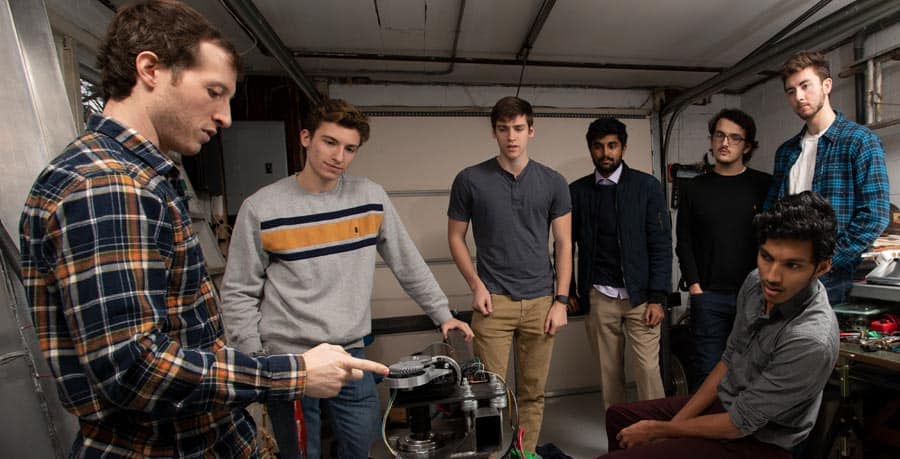
ABOVE: Adam Stager points to the prototype mechanism that steers the front wheel of the robot, while the TRIC team members look on. Pictured left to right: Stager, Nick Ulizio, Will Cantera, Srinath Venkatesh, Trevor Foresta, Jake Lubsen and Vishnu Somasundaram. Pre-pandemic photo by Kathy Atkinson
“With robotics you need lots of different brains to make things work, I can offer guidance, but it is the skills of every individual that make it possible. I need Ansel, an undergrad from Bard College, who is much better at programming than me, and Jake who is better at design, and so on.”
— Adam Stager
Meet the team
Students are a key part of the TRIC team, bringing enthusiasm, ingenuity and excitement to each project, all while gaining valuable technical training and leadership skills that will translate to the real world.
.
William Cantera
Trevor Foresta
Jacob Lubsen
Vishnu Somasundaram
Nick Ulizio
Srinath Venkatesh
A UD Robotics Revolution
This special section of our digital magazine highlights an autonomous revolution taking place at UD.
MORE STORIES
From the Vice President for Research, Scholarship and Innovation: Moving Forward
The UD research community continues to navigate COVID-19, with health and safety the highest priority. In spite of hardships, we’re facing the pandemic with vigilance and resilience.
News Briefs
Check out our COVID-19 research, a virtual visit with the editor-in-chief of Science, and undergrads at work on the Frontiers of Discovery.
Honors: Celebrating Excellence
UD faculty and students have won major recognition for their expertise and contributions.
Guess Who’s Powering Up UD’s Research Engine?
This issue of the University of Delaware Research magazine introduces you to a critical creative force at UD — our graduate students and postdoctoral researchers. Their ingenuity is lighting new routes to discovery and solutions.
Front Edge of Discovery: Strengthening democracy for a better world
It all began with a Joseph Conrad novel. Doctoral student Pablo McConnie-Saad discusses his journey to better understand democracy, as the first Whittington Graduate Fellow at the Biden Institute.
Front Edge of Discovery: Developing resilient Black girls
Doctoral student and Graduate Scholar Nefetaria Yates is examining school discipline and the tactics Black girls have developed for dealing with the pressures they face. Her ultimate goal is to elevate voices that have been silenced.
Front Edge of Discovery: Helping children move
Entrepreneur Ahad Behboodi wants to see kids with cerebral palsy move more freely. He plans to commercialize a robotic foot device with the power to help them.
Front Edge of Discovery: A clinical science approach
Lexie Tabachnick, in her fifth year of doctoral studies, helps to mentor other grad students and undergraduates while she studies the powerful impact a UD-developed family intervention program is having on vulnerable kids.
Front Edge of Discovery: Beyond the hands of a potter
Sanchita Balachandran, associate director of Johns Hopkins Archaeological Museum and doctoral student in preservation studies at UD, is uncovering the forgotten makers of ancient Greek ceramics, and in so doing, changing our understanding of the past.
Front Edge of Discovery: Changing the world, one food waste at a time
Elvis Ebikade thinks potato peels hold a lot of promise. He’s working on converting the food waste to valuable chemicals and fuels that can power an environmentally-friendly future.
Front Edge of Discovery: The thing about permafrost is…
As a postdoctoral researcher, Liz Coward collected samples of permafrost from the icy walls of a research tunnel in Alaska to study the carbon stored within it.
A Robotics Revolution
Researchers at the University of Delaware are leveraging robotic systems to gain traction on tough problems. Learn how they are driving forward transformative solutions in agriculture, precision medicine, health care, cybersecurity, marine ecology and more.
UD Robotics: Antarctic food webs
University of Delaware researchers Matthew Oliver and Katherine Hudson think that some biological hotspots in Antarctica may operate less like local farms and more like grocery stores. If they are correct, it could provide new information about how this ecosystem will be affected under climate change.
UD Robotics: Robots these days!
Brain-swarm technology is meant to connect minds and machines. For Associate Professor Panos Artemiadis such robotics research has one purpose: To make life and work better for humans.
UD Robotics: Meet me on the cutting edge
Sambeeta Das is forging into an exciting world you can see only with high-powered microscopes, where sci-fi meets reality. Welcome to the world of microrobots!
UD Robotics: Allies in Overcoming Stroke
Stroke is a leading cause of long-term disability, but UD Professor Jennifer Semrau is working to change that. With the help of a robot, she’s uncovering a critical sixth sense that gets sidelined with stroke.
UD Robotics: Social Robots
Children have grown up with interactive technologies like Siri, Google and Alexa, but they don’t always know how to stay safe online. UD researchers are working on ways to help them.
A Jewish Oral History
A class helps preserve the precious stories of a little-documented time in Jewish life.
Test Your Knowledge: Getting Back to Nature
To reduce stress and strengthen our immune systems, experts often point us to the outdoors. So let’s get moving! There’s lots to see and hear, absorb and appreciate in nature.


